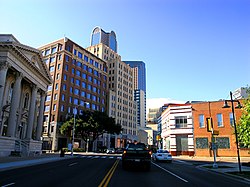| First Presbyterian Church | |
|---|---|
 Harwood Historic District structures including the First Presbyterian Church (far left) | |
| 32°46′46″N96°47′37″W / 32.77944°N 96.79361°W | |
| Location | 1835 Young St., Dallas, Texas |
| Country | United States |
| Denomination | Presbyterian Church (USA) |
| Website | fpcdallas |
| Architecture | |
| Architect(s) | C. D. Hill & Company |
| Style | Neoclassical Revival |
| Years built | 1912 [1] |
First Presbyterian Church and Activities Building | |
| Location | 401 S. Harwood St. |
| Part of | Dallas Downtown Historic District (ID08001299 [2] ) |
| DLMK No. | H/16 |
| DLMKHD No. | H/48 (Harwood HD) |
| Significant dates | |
| Designated CP | January 9, 2009 |
| Designated DLMK | October 21, 1981 [3] |
| Designated DLMKHD | February 28, 1990 [4] |
First Presbyterian Church of Dallas is a historic congregation at 1835 Young Street in the Farmers Market District of downtown Dallas, Texas (US). The current building is a contributing property in the Harwood Street Historic District and a Dallas Landmark. The congregation was founded in 1856 as the first U.S. (Southern) Presbyterian Church organized in Dallas, and is the mother church from which many other Presbyterian churches in the area have stemmed.



